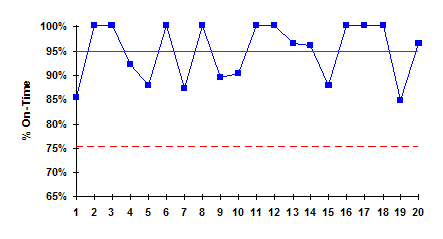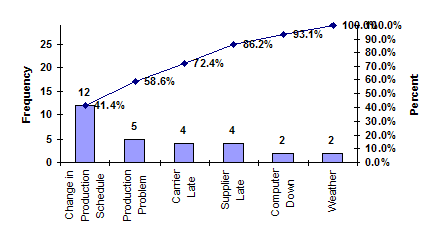June 2007
In this issue
- Defining On-Time Performance
- Measuring On-Time Performance
- Charting On-Time Performance
- Improving On-Time Performance
What percentage of time are your orders on time to your customers? Is this percentage consistent over time? Or is it improving? Or is it declining? And how do you know?
On-time delivery is almost always critical to the customer. If you cannot be on time consistently, the customer cannot plan his business. The key word in the sentence above is “consistently.” Your customer can make plans as long as the customer knows what your process will do. This month’s e-zine examines how statistical process control techniques can be used to monitor and improve on-time performance.
Defining On-Time Performance
The first step in improving on-time delivery is defining what it is. This is not an easy task. Each customer may have his own definition of on time. You will need to develop an operational definition for on-time delivery.
The Bureau of Transportation Statistics tracks on-time performance by the airlines. Its operational definition for on-time departure and arrival is the following:
A flight is counted as “on time” if it operated less than 15 minutes later than the scheduled time shown in the carriers’ Computerized Reservations Systems (CRS). Arrival performance is based on arrival at the gate. Departure performance is based on departure from the gate.
So, the airplane must leave within 15 minutes of the scheduled departure time to be leaving on time. This doesn’t mean that it departs any time soon after it leaves the gate. As those of you who travel know, the wait on the tarmac to takeoff can often be quite long. The plane must arrive within 15 minutes of the scheduled arrival time to arrive on time. Note that this means that they don’t have to open the door. They just have to be at the gate.
Many companies rely on third-party carriers to deliver their product. In this case, the company doesn’t control delivery after the product is ready to ship. Once the carrier picks up the order, it is out of the company’s hands. Of course, the company has the option to switch carriers or work with existing carriers to be sure that the carrier’s process is predictable. But, the company really doesn’t control the carrier. This is why most of these companies focus on on-time shipment (when the order is ready to ship) versus on-time delivery to the customer.
Sometimes the shipment date changes. Suppose you have a customer who orders a product for shipment by October 10. You discover that you can’t make the shipment by that date, but you can make the shipment by October 17. You call the customer and he tells you that is all right. You ship the product on October 15. Is it on time or late? This is the type of situation your on-time performance operational definition must handle.
Some organizations define on-time performance as the order arriving at the customer’s location on the first date entered into the order-entry system. But as you will see below, that is not always the case.
900 distribution center managers were surveyed by Karl B. Manrodt, PhD, an associate professor at Georgia Southern University, and Kate Vitasek, managing partner of Bellevue, WA-based Supply Chain Visions. The following is from this website.
Vitasek says one reason managers prefer to track when an order ships is because it’s easier to track. “It’s much tougher to obtain reliable data on precisely when the order was delivered.” And, given the respondent base of DC managers, it could be that this measure more accurately reflects their daily responsibilities, she says.
Perhaps a bigger issue, Vitasek says, is the apparent lack of consensus regarding what constitutes on-time delivery. When asked whether their customers defined on-time delivery differently, nearly 69% responded “yes.” How much variation could there possibly be in the definition of “on time?” Apparently, quite a lot: Many respondents (63.1%) indicated their customers simply defined an on-time delivery as a delivery on the requested or agreed-upon day. But others were more exacting-26.9% of the respondents said that “on time” meant delivery at an appointed time, or at least within a 30-minute window of that appointed time. Still others reported different definitions, including “By 4:00 PM.” This lack of agreed-upon standards and definitions goes a long way toward explaining why some suppliers have difficulty delivering “on time.”
A key point in this statement is that your operational definition for on-time performance should be something you can control or strongly influence. This is the only area you can actively improve. That is why companies which don’t do their own shipping often track whether the shipment is ready to ship on time and do not track on-time deliveries.
So step one in this process is to develop an operational definition for on-time performance. Only then can you begin to measure it and improve it.
Measuring On-Time Performance
Once you have set up your on-time performance operational definition, you must determine how to measure it. Too often, we believe we must measure all shipments. This is not true. You can take random samples of orders shipped each week or each month. Over time, this will give a true picture of your on-time performance process.
Another barrier to measuring on-time performance that is often thrown forward is that we cannot measure manually. It has to be done by the computer or it takes too much time. Sampling again handles this problem.
You will also want to consider collecting more information than just if the shipment was on time or not on time. The objective of measuring on-time performance is to improve it over time. This means you will want to collect data on reasons the shipment was not on time. This will provide you the data you need to begin working on improving on-time delivery.
The more frequently you analyze the on-time performance data, the better. This means you should look at the data at least weekly if at all possible. This makes it easier to investigate what has happened in the process.
You can use our ten step data collection process to help you design your measurement for on-time performance. This is given in our September 2004 newsletter.
Charting On-Time Performance
The best way to track on-time performance is to plot % on time as a time series chart. This allows you to see if the performance is staying the same, improving, or declining. Control charts provide an excellent means of doing this. What is the right type of chart to use?
Many use a p control chart to track on-time performance. The number of shipments per month is counted (n). This is the subgroup size. The number of on-time shipments is determined (np). The value of p (% on-time) is then calculated as the number on time/total number (p = np/n). This value of p is used in a p control chart.
This is not the right type of control chart to use for on-time performance. To use a p control chart, the probability that each shipment will be on time has to be constant for all shipments. This is seldom true. Sometimes you ship by air. The probability of this shipment being on time will be different than the probability for shipments which go the normal route.
The correct control chart to use is the individuals control chart. Below are example data for a company which tracks weekly on-time performance based on its operational definition. We will use the % on-time performance column in an individuals chart.
| Week Number | Number of Shipment | Number On-Time | % On-Time Performance |
| 1 | 20 | 17 | 85.0% |
| 2 | 23 | 23 | 100.0% |
| 3 | 27 | 27 | 100.0% |
| 4 | 25 | 23 | 92.0% |
| 5 | 24 | 21 | 87.5% |
| 6 | 29 | 29 | 100.0% |
| 7 | 23 | 20 | 87.0% |
| 8 | 27 | 27 | 100.0% |
| 9 | 28 | 25 | 89.3% |
| 10 | 30 | 27 | 90.0% |
| 11 | 21 | 21 | 100.0% |
| 12 | 22 | 22 | 100.0% |
| 13 | 27 | 26 | 96.3% |
| 14 | 24 | 23 | 95.8% |
| 15 | 32 | 28 | 87.5% |
| 16 | 21 | 21 | 100.0% |
| 17 | 24 | 24 | 100.0% |
| 18 | 28 | 28 | 100.0% |
| 19 | 32 | 27 | 84.4% |
| 20 | 27 | 26 | 96.3% |
The X chart for this data is shown in the figure below. We will not show the moving range chart. The on-time performance process is in statistical control. There are no points below the lower control limit and no patterns (like seven points in a row above or below the average). This means that it is consistent and predictable. You know what will happen in the future as long as the process stays the same. The process will average about 95% on time. Some weeks the on-time performance will be 100%; other weeks it may be as low as 75%.

And since the process is in control, the results for on-time performance will stay the same until the process is changed.
Improving On-Time Performance
Since the process is in statistical control, it must be fundamentally changed to improve the on-time performance. The key word here is fundamentally. The best approach to improving on-time performance is to form a team that uses a structured problem-solving model. The starting point would be examining the Pareto diagram for reasons for late shipments.
Below is an example of a Pareto diagram for reasons shipments were late. The biggest reason is changes to the production schedule. Most likely the “hot” order came in and was scheduled ahead of other orders, making them late. This gives you a starting point for improving the process. Remember that you should use a problem-solving methodology. For our problem-solving model, please see our May 2004 newsletter.

Summary
This month’s publication looked at how SPC can be used to monitor on-time performance. You need a good operational definition for what “on-time” is. Then you monitor the results using an individuals control chart along with a Pareto to track why something is not on-time. This allows you to pick the major reason, work on it. and see the improvement in the control chart.